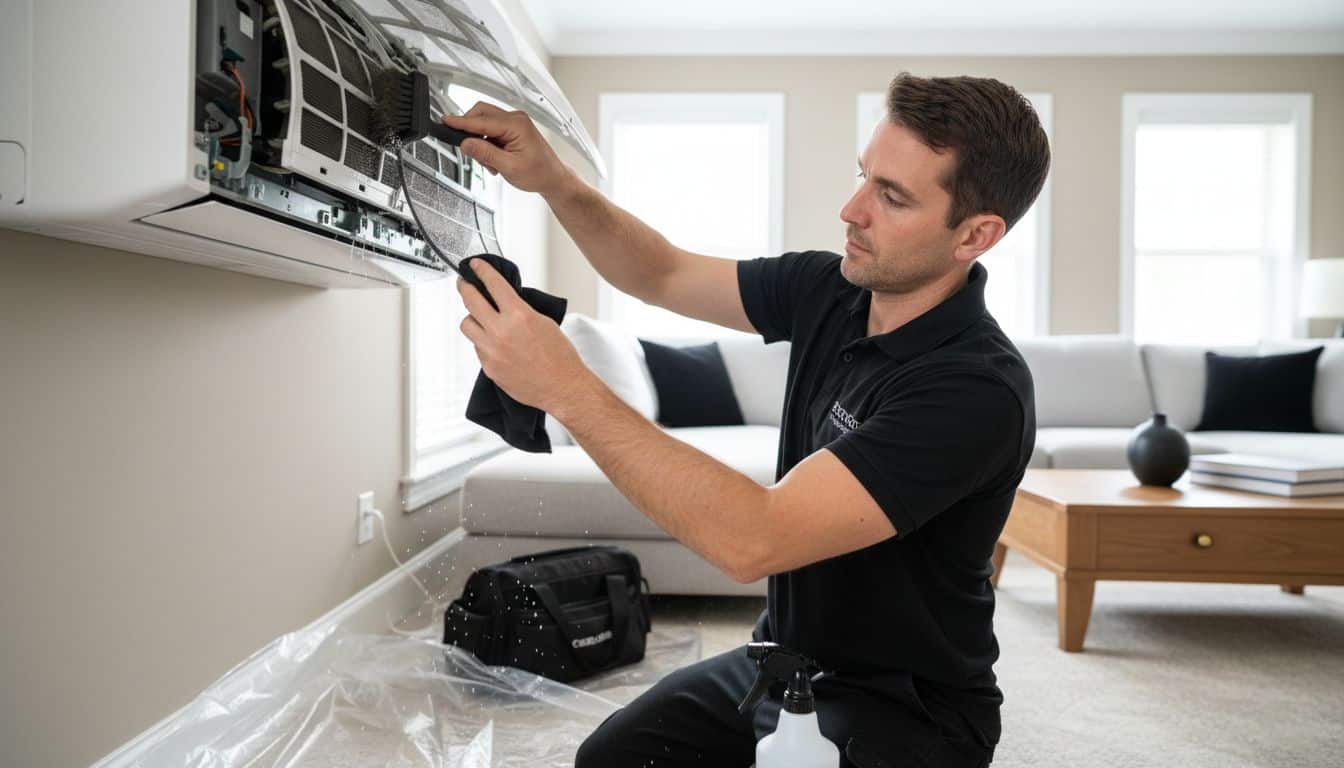
What Is Air Conditioning Cleaning? Complete Overview
Over 60 percent of AC systems lose efficiency each year due to hidden buildup and neglect. Clean air conditioning is about far more than fresh airflow. When dust, allergens, and microbes collect inside your AC, they can affect your health and drive up costs. By learning how proper cleaning works, you can protect your comfort, save money, and extend the system’s life. Discover what truly matters for cleaner, healthier indoor air.
Table of Contents
Contents
- 1 Table of Contents
- 2 Key Takeaways
- 3 Definition and Core Principles of AC Cleaning
- 4 Different Methods of Air Conditioning Cleaning
- 5 Key Stages in Professional AC Cleaning
- 6 Benefits for Health, Efficiency, and Longevity
- 7 Risks of Neglect and Common Misconceptions
- 8 Transform Your Indoor Air with Professional AC Cleaning Today
- 9 Frequently Asked Questions
- 10 Recommended
- Definition And Core Principles Of AC Cleaning
- Different Methods Of Air Conditioning Cleaning
- Key Stages In Professional AC Cleaning
- Benefits For Health, Efficiency, And Longevity
- Risks Of Neglect And Common Misconceptions
Key Takeaways
| Point | Details |
|---|---|
| Importance of AC Cleaning | Regular cleaning enhances energy efficiency, air quality, and extends the lifespan of air conditioning systems. |
| Structured Cleaning Process | Professional AC cleaning entails a systematic approach, including inspection, disassembly, and thorough sanitization of components. |
| Health Benefits | Clean AC systems reduce airborne allergens and harmful microbes, significantly improving indoor air quality and minimizing health risks. |
| Consequences of Neglect | Failing to maintain AC systems leads to decreased efficiency, higher energy costs, and potential health complications due to microbial contamination. |
Definition and Core Principles of AC Cleaning
Air conditioning cleaning is a comprehensive process designed to remove accumulated dirt, microbial contaminants, and debris from all critical components of an air conditioning system. According to research from iracst, maintaining clean AC components such as coils, fans, and ducts is essential for efficient heat transfer and optimal system performance.
The core principles of AC cleaning revolve around systematic removal and sanitization of system elements. Key objectives include:
- Eliminating accumulated dust and particulate matter
- Preventing microbial growth
- Restoring system efficiency
- Improving indoor air quality
- Extending equipment lifespan
Professional AC cleaning follows a meticulous approach recommended by industry standards like the ASHRAE Handbook. This involves comprehensive inspection, disassembly of system components, specialized cleaning techniques, and thorough sanitization. The process typically includes detailed cleaning of:
- Evaporator coils
- Condenser units
- Air filters
- Drainage systems
- Internal ductwork
By implementing rigorous cleaning protocols, property owners can ensure their air conditioning systems operate at peak performance while maintaining a healthy indoor environment.
Different Methods of Air Conditioning Cleaning
Air conditioning cleaning encompasses several specialized techniques designed to maintain system performance and indoor air quality. These methods range from traditional approaches to advanced technological solutions tailored to different system requirements and contamination levels.
Traditional cleaning methods include manual techniques such as chemical cleaning and manual brushing. These approaches typically involve:
- Dismantling AC components
- Using specialized cleaning solutions
- Manually removing dust and debris
- Wiping down and sanitizing individual parts
One innovative cleaning technique is dry-ice blasting, which Wikipedia describes as a non-abrasive method using solid carbon dioxide pellets accelerated in a pressurized air stream. This technique effectively removes contaminants without leaving residual moisture or chemical traces, making it particularly suitable for delicate electronic components and sensitive system parts.
Advanced cleaning methods also include ultrasonic cleaning and high-pressure steam cleaning. Learn more about professional AC cleaning methods in our comprehensive guide on types of AC cleaning, which provides detailed insights into selecting the most appropriate technique for your specific air conditioning system.
Professional AC cleaning services like SaniAC by Saniservice utilize a combination of these methods, ensuring thorough sanitization and optimal system performance. By employing scientifically validated techniques, these services can effectively remove microbial contaminants, improve energy efficiency, and extend the overall lifespan of air conditioning systems.
Key Stages in Professional AC Cleaning
Professional air conditioning cleaning is a systematic process that involves multiple precise stages designed to thoroughly restore and maintain HVAC system performance. According to research from iracst, the cleaning process includes high-pressure systems to remove dirt from coils and ducts, followed by critical antimicrobial treatments to improve air quality and prevent future buildup.
Initial Assessment Stage:
- Comprehensive system inspection
- Diagnostic evaluation of AC components
- Identifying specific contamination areas
- Determining appropriate cleaning methodology
The Preparatory Phase involves careful system disassembly and protection of sensitive electronic components. Technicians meticulously document the system’s current condition, ensuring every part is mapped and tracked throughout the cleaning process.
Cleaning Execution represents the core stage of professional AC maintenance. This involves:
- High-pressure cleaning of coils and internal surfaces
- Specialized chemical-free sanitization
- Removal of microbial contaminants
- Thorough debris extraction
Explore our comprehensive guide to the HVAC cleaning process for deeper insights into professional maintenance techniques. The final stage includes system reassembly, performance testing, and providing a detailed report of cleaning outcomes, ensuring optimal functionality and air quality for your air conditioning system.
Benefits for Health, Efficiency, and Longevity
Professional air conditioning cleaning delivers comprehensive benefits that extend far beyond simple maintenance. According to research from iracst, regular AC maintenance enhances system efficiency, reduces energy costs, improves indoor air quality by reducing allergens, and significantly extends the unit’s lifespan.
Health Benefits are particularly significant for residents in environments with high dust and humidity:
- Reduction of airborne allergens
- Elimination of harmful microbial contaminants
- Prevention of respiratory irritants
- Mitigation of mold and bacteria growth
From an Energy Efficiency perspective, clean air conditioning systems demonstrate remarkable performance improvements. The Kurahome guide highlights that proper air duct cleaning enhances airflow and reduces energy consumption, potentially leading to substantial cost savings on monthly utility bills.
The System Longevity advantages are equally compelling. By removing accumulated debris, preventing corrosion, and maintaining optimal component performance, professional cleaning can extend an air conditioning system’s operational life by several years. This proactive approach transforms AC maintenance from a reactive expense to a strategic investment in long-term comfort and reliability.
Explore our deep dive into AC cleaning benefits and techniques to understand how professional maintenance can transform your indoor environment and protect your valuable HVAC investment.
Risks of Neglect and Common Misconceptions
Neglecting air conditioning maintenance can lead to significant and potentially costly consequences for both system performance and human health. According to research from iracst, failure to maintain AC systems can result in mold growth, decreased efficiency, and increased health risks—with a critical warning that visible cleanliness does not guarantee internal system integrity.
Common Misconceptions:
- “My AC looks clean, so it doesn’t need maintenance”
- “Regular cleaning is an unnecessary expense”
- “Only visible dirt requires attention”
- “Modern systems don’t need frequent cleaning”
The hidden risks of AC system neglect extend far beyond surface-level concerns. Accumulated dust, moisture, and microbial growth can create breeding grounds for harmful organisms, potentially compromising indoor air quality and respiratory health. Microscopic contaminants can circulate through your living spaces, increasing risks of allergies, respiratory infections, and other health complications.
Economic implications are equally significant. Unmaintained systems experience progressive efficiency decline, leading to:
- Increased energy consumption
- Higher utility bills
- Premature system failure
- Expensive repair or replacement costs
Dive deeper into understanding the critical importance of professional AC maintenance to protect your health, comfort, and long-term financial investment.
Transform Your Indoor Air with Professional AC Cleaning Today
If you have been wondering how to eliminate hidden dust, mold, and allergens from your air conditioning system, it is time to take action. The challenges of unseen microbial growth and reduced system efficiency described in “What Is Air Conditioning Cleaning? Complete Overview” can severely affect your health and comfort. Saniservice offers a science-based solution that targets every component of your AC with proven chemical-free disinfectants and precision cleaning. We understand the importance of restoring your system’s performance while improving the air your family breathes.
Discover how our NADCA-certified technicians meticulously clean all parts including coils, ducts, and drainage trays to increase energy efficiency and extend your air conditioner’s lifespan.
Take control of your indoor environment now by visiting our AC Cleaning & Maintenance – Saniservice AC Cleaning page. Join countless clients who trust our expertise shown in detailed Case Studies – Saniservice AC Cleaning. To start improving your air quality and system longevity today, explore our full range of services at Saniservice and experience the lasting benefits of professional AC cleaning.
Frequently Asked Questions
What is air conditioning cleaning?
Air conditioning cleaning is a process aimed at removing dirt, microbial contaminants, and debris from all components of an air conditioning system to ensure efficient operation and improved indoor air quality.
Why is regular AC cleaning important?
Regular AC cleaning is essential for maintaining system efficiency, prolonging the lifespan of the unit, improving indoor air quality, and preventing health risks associated with mold and allergens.
What are the common methods used for air conditioning cleaning?
Common methods of air conditioning cleaning include manual cleaning, chemical cleaning, dry-ice blasting, ultrasonic cleaning, and high-pressure steam cleaning, each tailored to specific system needs and contamination levels.
What are the risks of neglecting air conditioning maintenance?
Neglecting air conditioning maintenance can lead to mold growth, decreased efficiency, increased energy costs, and health risks due to airborne contaminants, ultimately resulting in costly repairs or premature system failure.
Recommended
- Best Air Duct Cleaning Companies Near Me – Expert Comparison 2025 – Saniservice AC Cleaning
- AC Coil Cleaning Step by Step for Healthier Homes – Saniservice AC Cleaning
- AC duct cleaning companies that guarantee improved airflow – Saniservice AC Cleaning
- HVAC Cleaning Process 2025: Step-By-Step Guide for Healthier Air – Saniservice AC Cleaning


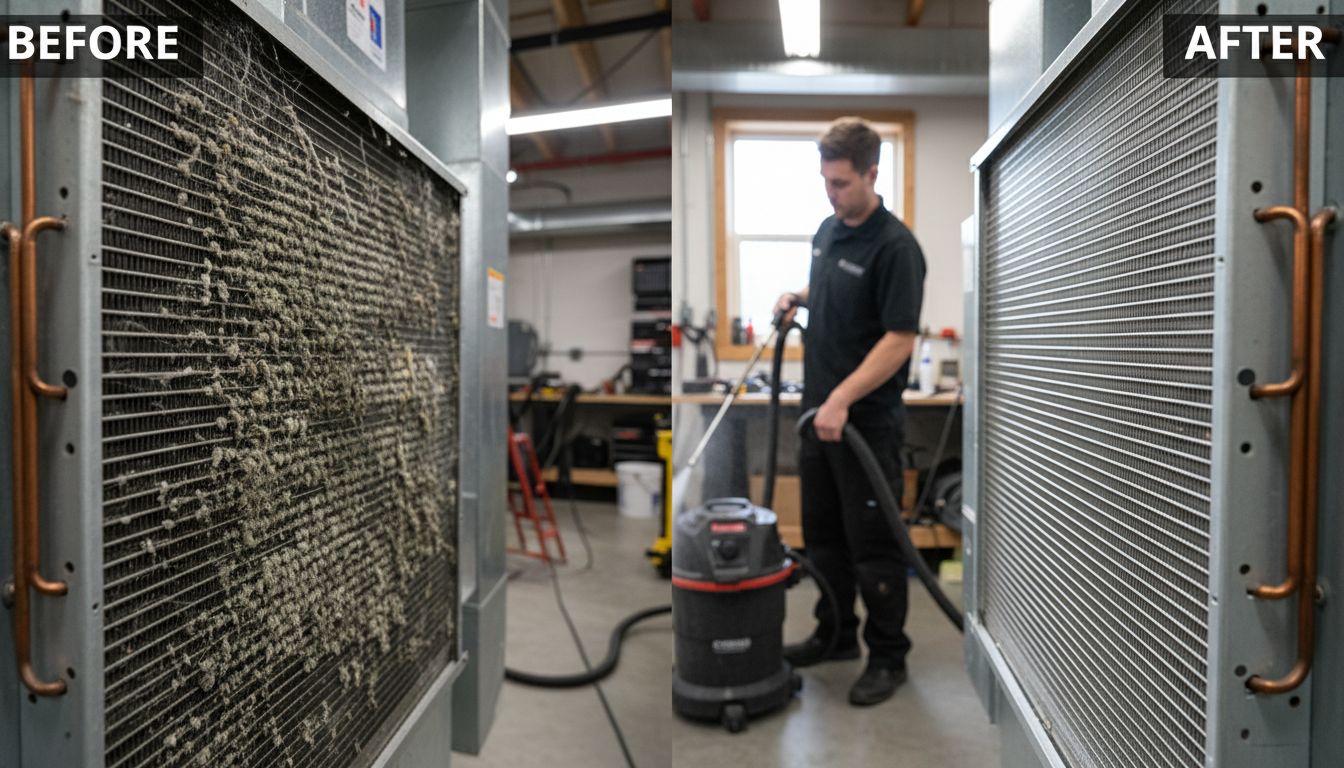
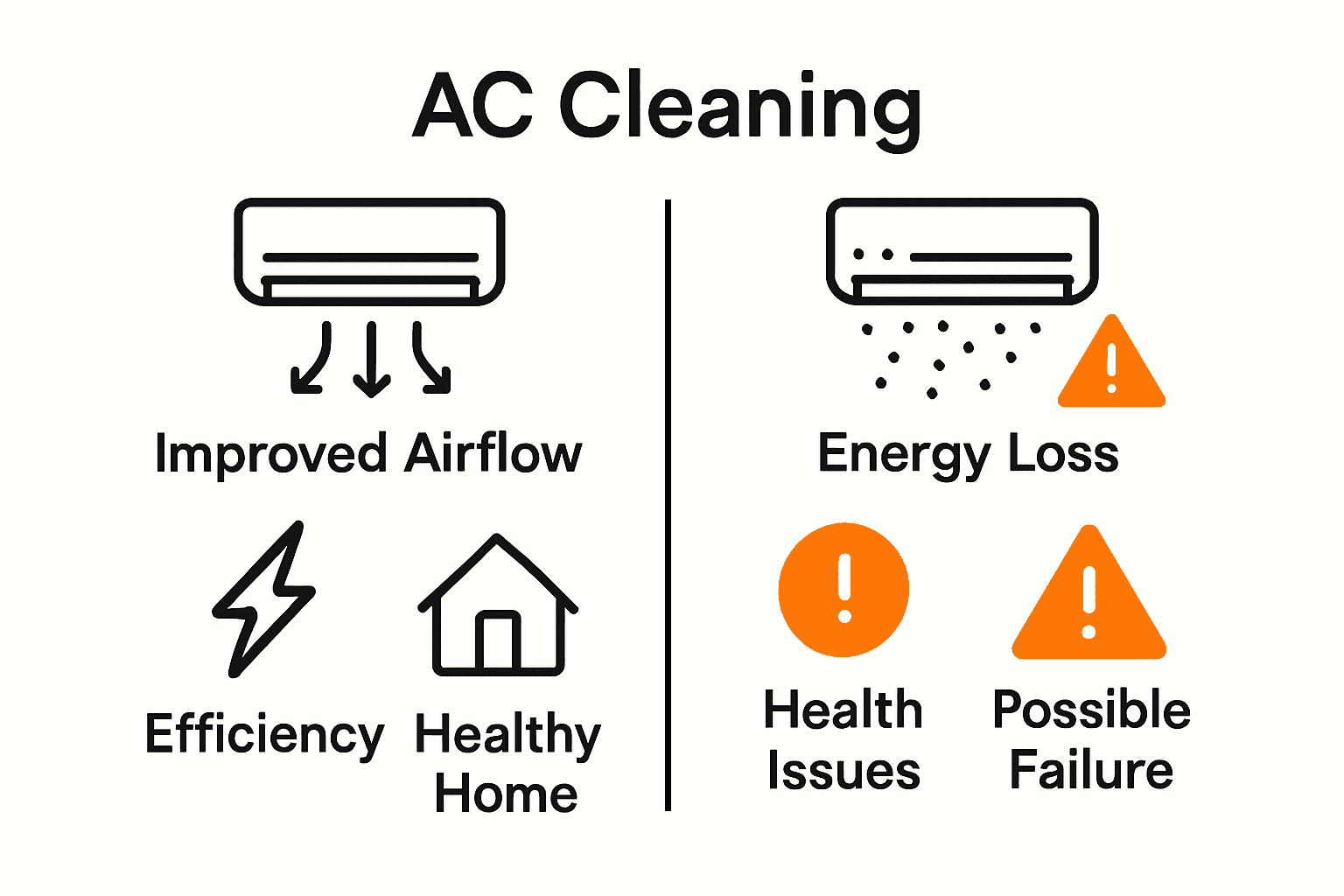
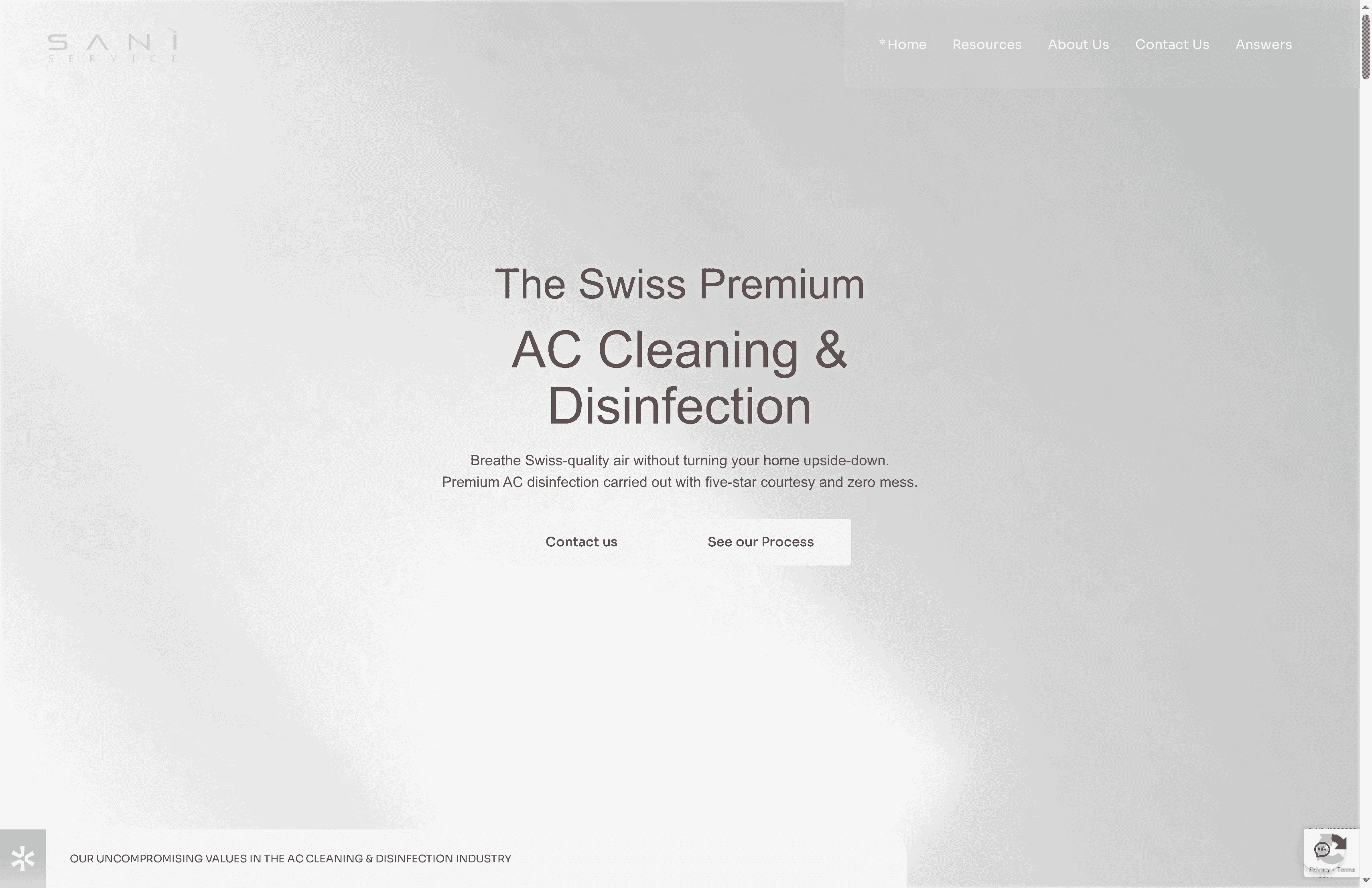


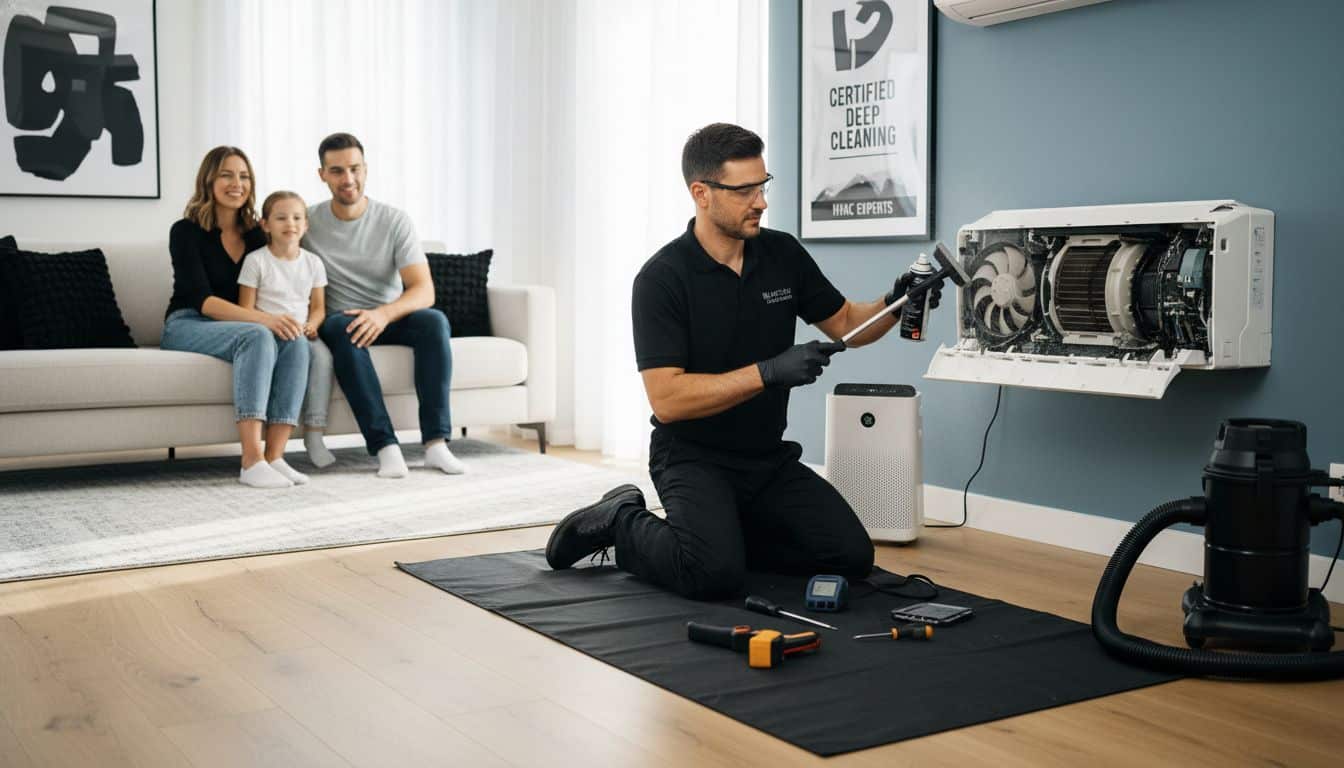

Leave a Reply